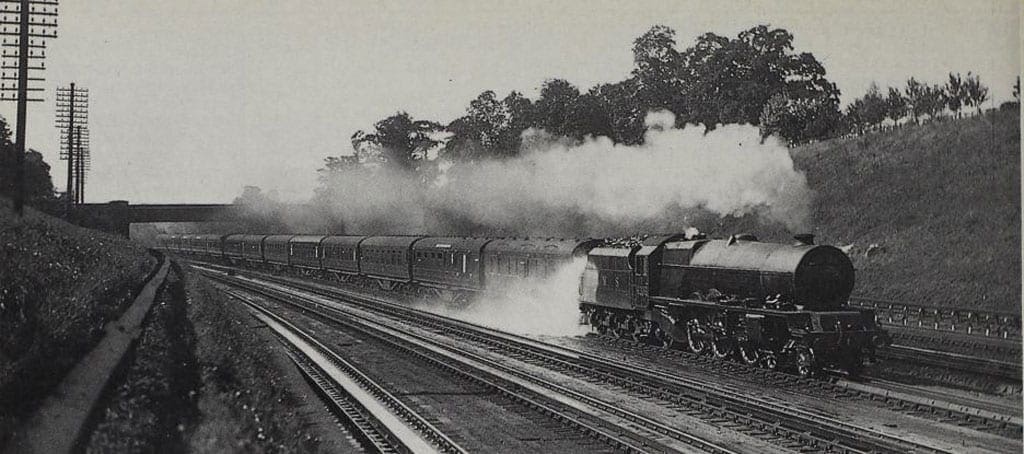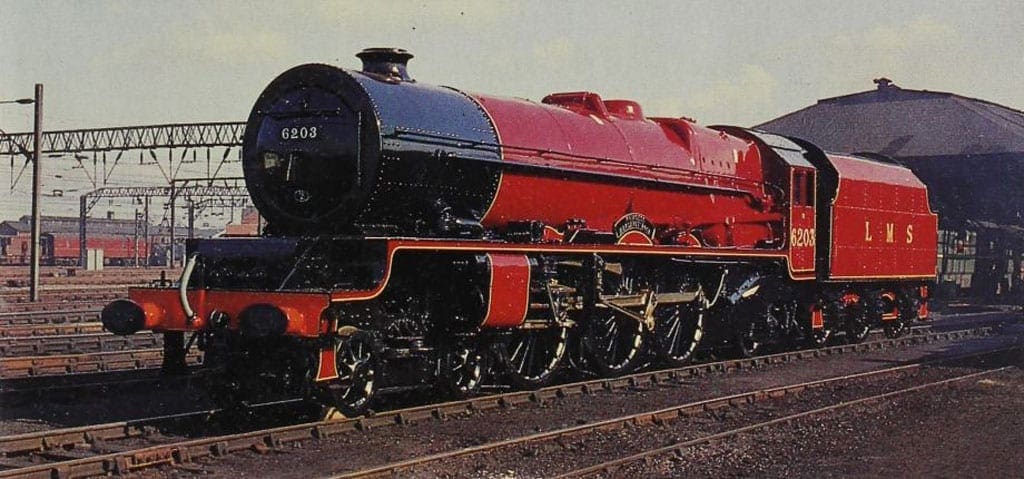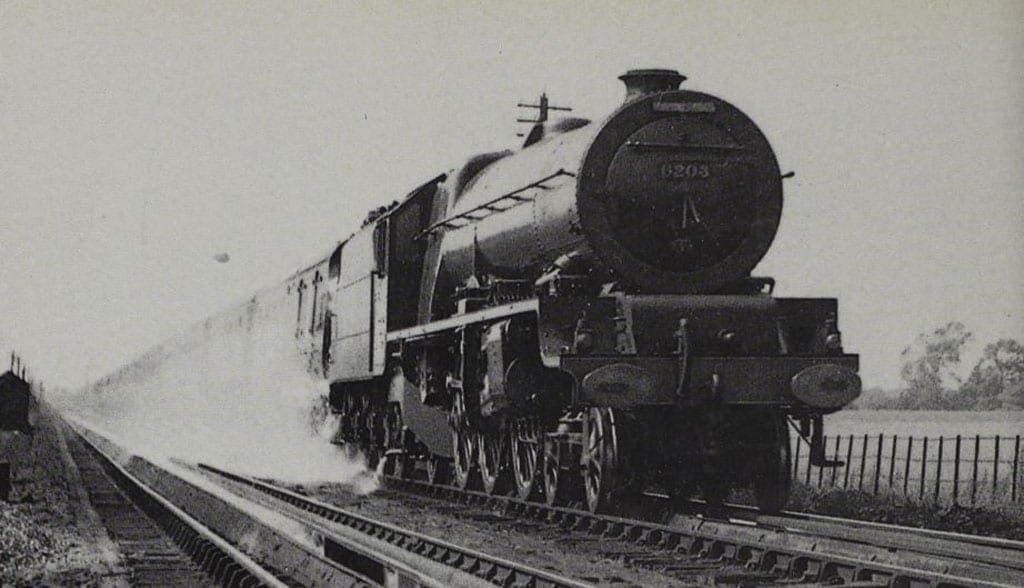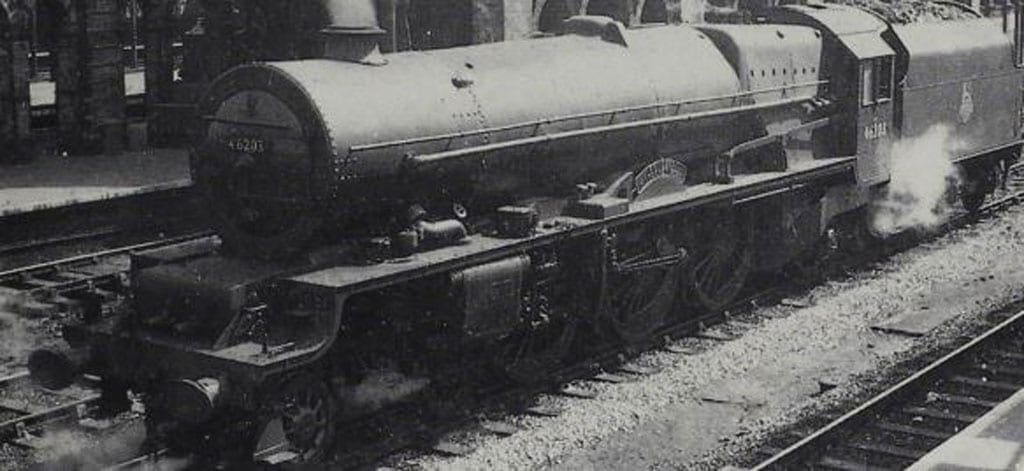
The Railway Magazine Archive | April 1990 | Words: Chris Milner
The year 1990 looks likely to be a vintage one for steam fans, with the return of several newly-refurbished big engines to the mainline. Chris Milner reports on the steady progress being made with just one of them—Stanier ‘Princess Royal’ Pacific No. 46203 ‘Princess Margaret Rose’.
This year, a record number of class 8 locomotives will be either returning to steam or making their debut appearances on main line railtours.
In order of appearance, they are GWR ‘King’ 4-6-0 No. 6024 King Edward 1 (February), LNER A4 Pacific No. 60009 Union of South Africa (February), BR Standard Pacific No. 71000 Duke of Gloucester (March), LMS ‘Duchess’ Pacific No. 46229 Duchess of Hamilton (April) and LMS ‘Princess Royal‘ Pacific No. 46203 Princess Margaret Rose (May/ June), with, hopefully, LNER A2 Pacific No. 60532 Blue Peter towards the end of the year.
Enjoy more Railway reading in the monthly magazine.
Click here to subscribe & save.
This year such an outpouring of top-drawer steam power is without parallel in the preservation world, and sharp-eyed enthusiasts may have noticed that there is one common factor connecting four of the locomotives: they are named after members of the Royal Family! 1990 should, therefore, turn out to be a right ‘royal’ year on the preserved steam scene. It is with just one of these locomotives though, that our story is concerned: ‘Princess Royal‘ No. 46203 Princess Margaret Rose.

No. 6203 as it was first numbered, was the first locomotive in the second batch of Stanier Pacifics built by the London Midland & Scottish Railway to haul heavy Anglo-Scottish express services between London Euston and Glasgow Central.
When Stanier took office as Chief Mechanical Engineer with the LMS in 1932, there was an urgent need for a large and powerful locomotive capable of working 500-ton trains over the London—Glasgow route with the gruelling climbs over Shap and Beattock. Before the introduction of Stanier’s Pacifics, existing
trains required an assisting engine for the ascent of these summits, and the LMS wished to eliminate this second-engine work.
The pioneer of the class, No. 6200 The Princess Royal, emerged from Crewe Works in July 1933, to Stanier’s design and was followed by the now-preserved No. 6201 Princess Elizabeth in November of the same year. They bore similarities in boiler pressure, cylinder size. driving wheel size and tractive effort to the Great Western ‘King’ 4-6-Os introduced some six years earlier, and with which Stanier was familiar. However, a much larger firebox and boiler had been used compared with the ‘King’ because of the arduous route over which the new Pacifics were to perform. The style of the overall locomotive design later became a Stanier characteristic.
Sadly, the pioneer locomotives suffered problems relating to boiler performance, and a considerable amount of research was carried out during 1934 to establish the cause. Following a re-design of the boiler a second batch of ten locomotives was ordered, numbered from 6203 to 6212. The unique ‘Turbomotive‘, No. 6202. also appeared in June 1935, followed by No. 6203 Princess Margaret Rose just one month later in July. The construction cost including the tender of No. 6203 was £9,692.

Beattock wit a northbound express circa 7952, when it was based at 66A Polmadie. At that time, its power classification had recently changed from 7P to 8P, which can be seen above the cabside number. Photo: The Rev. E. Treacy.
When new, No. 6203 began work on the West Coast Main Line heading such famous expresses ‘Mid-Day Scot‘. The locomotive was soon allocated to Polmadie shed, Glasgow, and during its short 27-year working career it was transferred to Camden Edge Hill, Holyhead and Crewe. The regular performances sustained by the class enabled the London—Glasgow timings to be reduced to 7 hr 35 min in 1936, and in May 1936 Princess Margaret Rose attained a record speed for the class at that time, reaching 102-5 mph through Leighton Buzzard with a seven-coach train.
As built, No. 6203 was fitted with a 4,000 gallon tender with a nine ton coal capacity. Under certain conditions, it became clear that this capacity was close to the limit so a modified version with a 10-ton coal capacity was introduced and attached to the locomotive in 1936.
To plan for a high-speed service for the 1937 timetable, the LMS began seeking faster times for its Anglo-Scottish express services, and during November 1936, sister locomotive No. 6201 Princess Elizabeth established a new record for speed and power output on the London – Glasgow route, with Beattock summit being passed at 56 mph. This record for continuous high speed running with a steam locomotive remains unbroken.

This one was taken by John F. Clay in June 1960, and by then the loco had a separate dome.
With this quest for increased speeds, many of the lessons learned in the construction and running of the ‘Princess Royals’ were utilised in the design of the ‘Coronation’ class which first appeared in June 1937. The new class had larger driving wheels, bigger fireboxes, five-row-40-element superheaters and streamlining.
After the introduction of the ‘Coronation’ class, many of the crack express trains became hauled by the new and more powerful Pacifics, and the ‘Princess Royal’ class found work on Liverpool and Manchester expresses as well as the slower and heavier trains to and from Glasgow.
During their lifetime, the ‘Princesses’ suffered problems associated with slight movement on the outside cylinders. For this reason, towards the end of 1951, Princess Margaret Rose was taken into Derby Works. The remedy consisted of metal strips being welded fore and aft of the outside cylinder block on to the frames. This modification was later extended to other ‘Princess Royal’ locomotives. The repair of No. 46203 at Derby was the first and only time a Stanier Pacific had been repaired at Derby works.
There was intense rivalry between Derby and Crewe Works, and within a few weeks of this repair being completed, the locomotive was ‘shopped’ at Crewe, probably just to see what Derby had actually done!
Princess Margaret Rose was withdrawn in October 1962, at Carlisle Kingmoor, when it was declared ‘surplus to requirements’, having done little more than 6,000 miles since it had been last ‘shopped’ at Crewe. Total mileage at time of withdrawal was 1,494,484.

No doubt No. 46203 would have been cut up had it not of have been for holiday camp boss Billy Butlin (later Sir Billy) wanting to buy some BR locomotives. Initially he enquired about No. 46201 Princess Elizabeth, but this had been sold to the 6201 Society. However, the London Midland Stores Controller at the time, a Mr. A. B. McLeod, offered No. 46203 instead, which was accepted. The Stanier Pacific was taken to Crewe for the last time to be re-painted and then was taken off to Butlin’s Pwllheli campsite.
The novelty of a real steam engine began to wear thin on the campers, and Princess Margaret Rose began to look in a woeful condition. The efforts of David Ward, who was Director of the Transport Trust and is currently British Rail Charter Train Unit Director, were instrumental in the negotiations to take Princess Margaret Rose away from Pwllheli.
An agreement was reached in April 1974 under which the locomotive was to be moved to the Midland Railway Trust site near Derby. At that time. the Midland Railway Trust was a charitable organisation which planned to develop a full—sized working railway in the Derby area. Since then the railway based at Butterley has become one of the country‘s leading preserved lines, with many fine examples of Midland or LMS locomotives, carriages. wagons and signalboxes.
The task of moving a 74 ft locomotive and tender from the camp site is really a story in itself. Enquiries to move the locomotive by road to Derbysbire found no response. Attempts for a road movement to the nearest railhead at Pen-y—Chain also proved fruitless so the Midland Railway Trust decided to undertake the task with its own volunteer force. Although the direct distance to connect with BR was just over 400 yd the total distance, with all the backward and forward movement, was nearer 1,000 yd. Certainly this was no simple task with a locomotive and tender weighing nearly 160 tons. To complicate the task of the workforce even more, BR insisted at the eleventh hour that it wanted the engine turning through 180 degrees.

The whole episode was not without incident, either. On one occasion No. 6203 nearly ended up in the boating lake, and on another, the camp site Fire Brigade, while on an exercise, came round a bend only to be faced by a Stanier Pacific. The story goes that they managed to avoid hitting it, just!
With the engine back on BR metals, the planned 12 hour movement back to Derby also had problems when the class 24 hauling Princess Margaret Rose failed on Talerddig bank. Fortunately, the fault was repaired by Midland Railway Trust fitters who, by coincidence, worked at Derby Works.
Derby was reached almost on schedule, and the locomotive was put on display at two works open days before moving to Butterley in October 1975. During the intervening years, No. 6203 was used as an externally restored static exhibit, still owned by Butlin’s. During 1985, the locomotive was re-painted in BR Brunswick green livery.
In 1986, Butlin’s decided to relinquish ownership of Princess Margaret Rose and the Midland Railway Trust, as custodian, was offered the locomotive. An appeal to raise the £60,000 asking price was quickly established, but then wound up because of insufficient response. At that point Brell Ewart, a Director of a local civil engineering construction firm and also a Midland Railway Trust Director, decided to purchase the locomotive.

A decision was subsequently made to restore the magnificent locomotive to main line running condition, and work began on the overhaul in September 1988. Funding for this restoration is being provided privately by owner Brell Ewart.
The locomotive had received a Heavy Intermediate overhaul at Crewe in 1961, and despite suffering the sea air at Butlin’s for 12 years, mechanically Princess Margaret Rose was in very good condition.
Restoration of the locomotive has been confined mainly to a strip-down and refurbish exercise. Platework has been replaced on the running plate and new platework has been fitted under the cab floor.
After removal, the cab was shot-blasted and painted. A lot of work has been done on the tender though, with much replacement of wasted platework. Additionally, the tender has had new inner frames and a new drag-box. During the tender’s rebuild, the decision was made to incorporate an auxiliary water tank, independent of the main 4,000 gallon capacity. This novel feature has been constructed in the triangular void at the back of the tender and has a capacity of 750 gallons. The construction of the tank has been done so it does not protrude above the characteristic curved sides of the Stanier tender. Use of the auxiliary tank is controlled by a special valve, allowing the contents to drop into the main tender tank. Coal capacity has been reduced by half a ton.
The driving wheels have been removed and the axleboxes re-metalled, as have the front bogie and pony wheels. No attention was required to the driving wheel tyres as these are virtually new. All springs have been tested as acceptable, with no repairs or replacement necessary. The valves and pistons have been stripped down and reassembled, with new rings on the pistons.
A lot of boiler work has been done in order to comply with current BR directives. New small tubes and flue tubes have been fitted, the flues being manufactured in West Germany at a factory under the Wuppertal Overhead Railway. The original superheater elements were found to be in perfect condition after hydraulic testing. All firebox stays have been replaced and the front tubeplate has been removed to be welded and straightened. A new smokebox has been fabricated and a new smokebox door has also been manufactured. As yet, the boiler has to be steamed, but steam testing is expected some time around mid March. The boiler should be re—united with the frames towards the end of March with re-assembly of the locomotive completed, hopefully, by the end of April.

After a period of running-in at Butterley, Princess Margaret Rose will go to Derby for weighing followed by the compulsory BR load test run. The final livery of the locomotive is being kept a well-guarded secret, and is known only by a select few. In addition, loco owner Brell Ewart told The Railway Magazine that the test run may be carried out in primer, which will keep the enthusiasts guessing even longer. The appearance of Princess Margaret Rose on the BR main line will be a very welcome sight.
At the time of my visit to monitor progress on Princess Margaret Rose, by coincidence a party of ex-BR staff who were involved with work on the locomotive or its movement to Derby Works was visiting Butterley. The purpose of the visit was to acquaint them with the progress being made, and hear any interesting stories that surrounded the locomotive‘s repair at Derby.
From this and other information, Midland Railway Trust Vice Chairman Brian Radford is to compile a comprehensive book about Princess Margaret Rose from construction through to preservation. Publication is planned for spring, 1991.
It is expected that Princess Margaret Rose will make its main line railtour debut on 2 June, when two circuits of the Derby—Toton—Sheffield—Derby circle will be made. The tour is being organised by the John Player Railway Club and will originate from London St. Pancras. Proceeds from the railtour will go to a memorial fund in memory of Richard Levick, who was killed at the Midland Railway Trust workshops.
For the rest of 1990, Princess Margaret Rose is being considered for an appearance at Coalville Open Day on 3 June and it is in the locomotive pool for the Marylebone-Derby—Sheffield ‘White Rose’ tours and the ‘Cumbrian Mountain Express’ excursions.
My thanks are due to Brell Ewart, Chris Banks and John F. Clay for their valued assistance in the preparation of this article.




